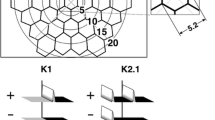Abstract
We examined the possibility that the 100- to 1000-Hz oscillatory potentials could represent the derivative version of the 1- 1000-Hz electroretinogram. Corneal electroretinograms were recorded from rabbits by means of bandwidths of 1–1000 Hz, 10–1000 Hz, 30–1000 Hz and 100–1000 Hz (6 dB of attenuation). Derivatives of the 1- to 1000-Hz electroretinogram had a waveform similar to the 100- to 1000-Hz signals, but of larger amplitude (21.9% ± 16.7% larger, n = 16). Similarly, integration of the 100- to 1000-Hz signal resulted in a wave-form whose amplitude was 60% of the original 1- to 1000-Hz electroretinogram. Our results suggest that some aspect of the morphologic changes seen when the low-frequency cutoff of the recording bandwidth of the ERG is increased from 1 Hz to 100 Hz could be explained with a simple derivative model. The oscillatory potentials may be significant contributors to the morphogenesis of the 1- to 1000-Hz electroretinogram.
Similar content being viewed by others
References
Brown KT, Wiesel TN. Localization of origins of electroretinogram components by intraretinal recording in the intact cat eye. J Physiol 1961; 158: 257–80.
Heynen H, Van Norren D. Origin of the electroretinogram in the intact macaque eye, II: Current source-density analysis. Vision Res 1985; 25: 709–15.
Witkovsky P, Nelson J, Ripps H. Action spectra and adaptation properties of carp photoreceptors. J Gen Physiol 1973; 61: 401–23.
Dick E, Miller RF, Bloomfield S. Extracellular K + activity changes related to electroretinogram components, II: Rabbit (e-type) retinas. J Gen Physiol 1985; 85: 911–31.
Miller RF. Role of K + in generation of b-wave of electroretinogram. J Neurophysiol 1973; 36: 28–38.
Miller RF, Dowling JE. Intracellular responses of the Muller (glial) cells of mudpuppy retina: Their relation to the b-wave of the electroretinogram. J Neurophysiol 1970; 33: 323–41.
Heynen H, Wachtmeister L, Van Norren D. Origin of the oscillatory potentials in the primate retina. Vision Res 1985; 25: 709–15.
Ogden TE. The oscillatory waves of the primate electroretinogram. Vision Res 1973; 13: 1059–74.
Wachtmeister L, Dowling JE. The oscillatory potentials of the mudpuppy retina. Invest Ophthalmol Vis Sci 1978; 17: 1176–88.
Yonemura D, Masuda Y, Hatta M. The oscillatory potential in the electroretinogram. Jpn J Physiol 1963; 13: 129–37.
Karwoski C. Retinal extracellular potential responses not evoked by light. In: Heckenlively JR, Arden GB, eds. Principles and practice of clinical electrophysiology of vision. St. Louis: Mosby Year Book, 1991: 129–31.
Wachtmeister L. Oscillatory potential recording. In: Heckenlively JR, Arden GB, eds. Principles and practice of clinical electrophysiology of vision. St. Louis: Mosby Year Book, 1991: 322–7.
Lachapelle P. A possible contribution of the optic nerve to the photopic oscillatory potentials. Clin Vision Sci 1990; 5: 421–6.
Lachapelle P, Little JM, Polomeno RC. The photopic electroretinogram in congenital stationary night blindness with myopia. Invest Ophthalmol Vis Sci 1983; 24: 442–50.
Speros P, Price J. Oscillatory potentials. History, techniques and potential use in the evaluation of disturbances of retinal circulation. Surv Ophthalmol 1981; 25: 237–52.
Algvere P, Westbeck S. Human ERG in response to double flashes of light during the course of dark adaptation: A Fourier analysis of the oscillatory potentials. Vision Res 1972; 12: 195–214.
Asi H, Leibu R, Perlman I. Frequency-domain analysis of the human corneal electroretinogram. Clin Vision Sci 1992; 7: 9–19.
Gur M, Zeevi Y. Frequency-domain analysis of the human electroretinogram. J Opt Soc Am 1980; 70: 53–9.
McCulloch JA, Orpin JW, Waisberg P, Parker JA. Frequency analysis of the human dark-adapted electroretinogram. Can J Ophthalmol 1972; 7: 189–98.
Tsuchida Y, Kawasaki K, Fujimura K, Jacobson JH. Isolation of faster components in the electroretinogram and visual evoked responses in man. Am J Ophthalmol 1973; 75: 846–52.
Lachapelle P, Molotchnikoff S. Components of the electroretinogram: A reappraisal. Doc Ophthalmol 1986; 63: 337–48.
Odom V. Amplifiers and special-purpose data acquisition systems. In: Heckenlively JR, Arden GB, eds. Principles and practice of clinical electrophysiology of vision. St. Louis: Mosby Year Book, 1991: 183–92.
Lachapelle P, Blain L. A new speculum electrode for electroretinography. J Neurosci Methods 1990; 32: 245–9.
Maccabee PJ, Hassan NF, Cracco RQ, Schiff JA. Short latency somatosensory and spinal evoked potentials: Power spectra and comparison between high pass analog and digital filter. Electroencephalogr Clin Neurophysiol 1986; 65: 177–87.
Rossini PM, Cracco RQ, Cracco JB, House WJ. Short latency somatosensory evoked potentials evoked to pereoneal nerve stimulatior: Scalp topography and the effect of different frequency filters. Electroencephalogr Clin Neurophysiol 1981; 52: 540–52.
Suprynowicz VA. Introduction to electronics. Reading, Mass. Addison- Wesley Publishing Co. Inc., 1966: 79–85.
Khani-Oskouee K, Sieving PA. A digital band-pass filter for electrophysiology recording systems. In: Heckenlively JR, Arden GB, eds. Principles and practice of clinical electrophysiology of vision. St. Louis: Mosby Year Book, 1991: 205–10.
Buckser S.Analysis of the multiple peaks in the ERG b-wave. The clinical value of electroretinography, ISCERG Symp (Ghent 1966), 1968: 183–93.
Heck J, Rendahl I. Components of the human electroretinogram. Acta Physiol Scand 1957; 39: 167–75.
Lachapelle P. Analysis of the photopic electroretinogram recorded before and after dark adaptation. Can J Ophthalmol 1987; 22: 354–61.
Lachapelle P, Benoit J, Guité P, Ngoc Tran C, Molotchnikoff S. The effect of iodoacetic acid on the electroretinogram and oscillatory potentials in rabbits. Doc Ophthalmol 1990; 75: 7–14.
Author information
Authors and Affiliations
Rights and permissions
About this article
Cite this article
Lachapelle, P., Benoit, J. Interpretation of the filtered 100- to 1000-Hz electroretinogram. Doc Ophthalmol 86, 33–46 (1994). https://doi.org/10.1007/BF01224626
Accepted:
Issue Date:
DOI: https://doi.org/10.1007/BF01224626




